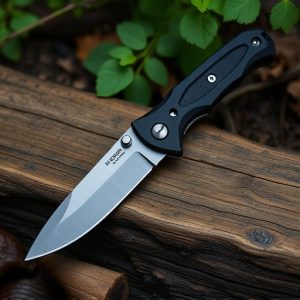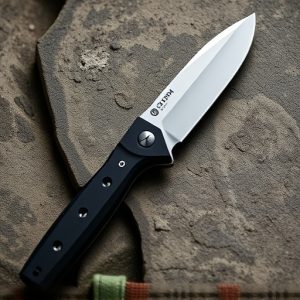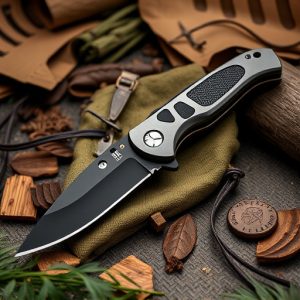Mastering OTF Automatics: A Comprehensive Guide to Ownership, Evolution, and Care
OtTF (One-Time-Fly) automatic knives, commonly known as OTFs, are advanced tactical tools that blen…….
OtTF (One-Time-Fly) automatic knives, commonly known as OTFs, are advanced tactical tools that blend sophisticated technology with practical design. These devices are known for their rapid and reliable blade extension, thanks to a precise calibration of the main spring, piston assembly, and durable stainless steel blades. They come equipped with safety features like a trigger lock and a safety mechanism to prevent accidental activation while ensuring the knife is operational when needed. The mechanics behind OTFs are crucial for users to understand for both appreciation of their engineering and effective operation and maintenance, which is essential for law enforcement, military personnel, and collectors who rely on these knives for their practicality and sophistication in various applications.
Originating from military origins, OTF automatic knives have evolved into mainstream civilian utility items, prized for their sleek design and rapid deployment. Today's OTFs reflect both technological advancements and the diverse needs of consumers, with each model tailored to specific tasks and environments. As innovation continues, these knives solidify their role as a testament to modern engineering prowess and an integral part of personal defense strategies and everyday carry practices.
Legal ownership of OTF automatic knives is subject to complex federal and state regulations in the United States. The 1958 Federal Switchblade Act governs interstate sale, transfer, and possession at the federal level, categorizing OTFs as switchblades. State laws vary widely, ranging from bans to permissive use, with conditions often including age restrictions and blade length limitations. Understanding these regulations is crucial to avoid significant legal penalties.
When selecting an OTF automatic knife, considerations must include the quality of the stainless steel blade—materials like AUS-8 or VG-10 are recommended for edge retention and ease of maintenance. The deployment mechanism should be seamless and ambidextrous, with a robust locking system to secure the blade open and a finger guard for safety. Some models may include additional manual safety switches for heightened security. For maintenance, after each use, clean the knife thoroughly, apply appropriate lubricant to the internal mechanism, and inspect for wear or damage regularly. This diligent care ensures the knife remains in peak condition, ready and reliable for its intended use.
OTF automatic knives have captivated enthusiasts with their seamless deployment and robust performance. This article delves into the intricacies of these mechanisms, their evolution from military tool to a staple in everyday carry, and the legal landscape that frames their use. We’ll explore key features that define top-tier OTF knives and provide maintenance tips for maintaining their peak condition. Join us as we unravel the essence of OTF automatic knives.
Understanding OTF Automatic Knives: A Primer on Mechanisms and Functions
Otdelnoye vozduhnoye oruzhie, or OTF automatic knives, represent a fascinating blend of technology and practicality in the realm of tactical tools. These devices are not merely blades that open and close; they embody a complex system of mechanisms designed for swift deployment and reliability under various conditions. An OTF automatic knife functions through a series of internal gas pressure-driven pistons that propel the blade out of its handle when activated. This action occurs almost instantaneously, allowing for rapid deployment in self-defense or quick-use scenarios. The mechanism typically involves a trigger lock and a safety to prevent accidental activation, ensuring user safety while maintaining the knife’s readiness for use.
The functionality of an OTF automatic knife is centered around its pivotal internal parts, which include the main spring, the piston assembly, and the blade itself, all meticulously calibrated to work in concert. The blade, often made from durable materials like stainless steel, is designed to withstand the stresses of rapid deployment and repeated use without failure or compromising its edge. The design of these knives prioritizes both the ease of operation and the robustness needed for real-world applications, making them a tool of choice for law enforcement, military personnel, and discerning collectors alike. Understanding the intricacies of how OTF automatic knives operate not only deepens one’s appreciation for their engineering but also enhances the user’s ability to handle and maintain these sophisticated tools effectively.
The Evolution of OTF Automatic Knives: From Military Origins to Everyday Carry
The development and evolution of OTF, or One-Time-Fly, automatic knives have a rich history that dates back to their military origins. Initially conceived for tactical purposes, these compact blades were engineered to deploy swiftly and with precision, providing soldiers with a rapid defensive tool during operations. Over time, the technology behind OTF knives has advanced significantly, leading to improvements in reliability, durability, and functionality. Today, these mechanisms are not only employed for their original intended use but have also become popular as everyday carry items among civilians. The sleek design and quick deployment of an OTF automatic knife make it a practical choice for individuals who value efficiency and discreetness in their daily lives. The evolution of this technology has been driven by both technological advancements and changing consumer preferences, which have led to a variety of models available on the market, each tailored to specific needs and use cases. From the battlefield to urban environments, the OTF automatic knife has transitioned from being a niche military tool to a versatile accessory for a wide range of users. The ongoing innovation in this field continues to expand the utility and appeal of these remarkable devices, solidifying their place as both a piece of modern engineering and a staple in personal defense and everyday carry.
Legal Considerations and Regulations Governing OTF Automatic Knife Ownership
Otf automatic knives, often referred to as automatic or switchblade knives, are subject to stringent legal regulations due to their potential for rapid deployment. The possession, carrying, and use of these devices are governed by both federal and state laws across the United States, with variations in regulations impacting individual rights and responsibilities. At the federal level, the sale, transfer, and possession of OTF automatic knives interstate or importation are regulated under the Federal Switchblade Act of 1958, which defines a switchblade as any knife with a blade that releases from the handle or sheath by the force of gravity or by manual pressure applied to a button, spring, or other releasing device.
State laws further delineate specifications regarding the legality of OTF automatic knives. Some states prohibit their ownership and carry, while others allow them under certain conditions, often including age restrictions, limits on blade length, and specifications for safety features. It is imperative for individuals to familiarize themselves with the applicable laws in their jurisdiction before acquiring an OTF automatic knife. Non-compliance can lead to legal consequences ranging from fines to criminal charges. Users must also adhere to local ordinances, as municipalities may have additional restrictions that are more stringent than state laws. Understanding these legal considerations is essential for responsible ownership and use of OTF automatic knives.
Key Features to Look for in an OTF Automatic Knife
When considering the acquisition of an OTF, or one-handed opening automatic knife, it’s crucial to evaluate several key features that can influence both safety and performance. Firstly, the blade material is a significant factor; high-quality stainless steel is preferred due to its durability, resistance to corrosion, and ability to maintain a sharp edge over time. A notable option within this category includes AUS-8 or VG-10 steels, which are known for their excellent edge retention and ease of sharpening.
Furthermore, the mechanical design of the OTF automatic knife is pivotal in determining its reliability and user experience. Look for a model with a smooth and consistent deployment mechanism, often referred to as the “out-the-front” or OTF mechanism. This feature should be ambidextrous, allowing for operation with either hand without compromising on efficiency or ease of use. The locking mechanism is equally important; it must be robust enough to securely hold the blade when opened and user-friendly to engage and disengage with minimal effort. Safety features such as a finger guard and a securely fastened blade when closed are non-negotiable, ensuring that the knife cannot accidentally deploy or injure the user or bystanders. Additionally, some OTF automatic knives come with a manual safety switch for added security. Considering these features will help you choose an OTF automatic knife that offers both functionality and safety.
Maintenance and Care: Ensuring Your OTF Automatic Knife Stays in Optimal Condition
When it comes to maintaining an OTF automatic knife in optimal condition, regular upkeep is key. To preserve the blade’s sharpness and the mechanism’s reliability, clean the knife thoroughly after each use, especially if it has been used in a dirty or corrosive environment. Use a soft cloth lightly dampened with warm, soapy water to wipe down the blade and handle, taking care not to disassemble any parts unnecessarily. For the internal components, lubricate them with a small amount of a high-quality lubricant specifically designed for tactical or automatic knives. This ensures that the springs and pivot points remain smooth and free of debris that could cause premature wear or failure. It’s also important to periodically inspect the knife for signs of corrosion or damage, particularly on the pivot points and moving parts. If any issues are detected, address them immediately by disassembling the knife partially or fully, depending on the severity, and cleaning or replacing affected components. Keeping your OTF automatic knife clean, well-lubricated, and in good repair will not only extend its lifespan but also ensure it’s ready for use whenever you need it. Regular maintenance is a critical aspect of owning an OTF automatic knife, as it is a sophisticated piece of machinery that combines functionality with precision engineering.


